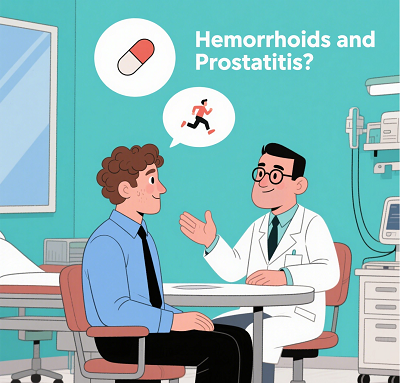Hemorrhoids and Prostatitis at the Same Time? Here's How to Treat Both Effectively
Charles is now 53 years old. Recently during bowel movements, he noticed something protruding from his anus with some pain, and there were drops of bright red blood on the toilet paper. Realizing he might have developed hemorrhoids, he went to the hospital for consultation.

After carefully examining Charles' hemorrhoidal area and prostate, the doctor said: "Actually, your hemorrhoids are caused by prostate enlargement. The long-term difficulty in urination leads to increased abdominal pressure, causing blood reflux obstruction in the rectal veins, which then become engorged and form hemorrhoids. Therefore, while treating the hemorrhoids, we must also control the prostate enlargement." Only then did Charles understand that he was suffering from both hemorrhoids and prostatitis simultaneously.
Why Do Hemorrhoids and Prostatitis Occur Simultaneously?
Because the prostate and rectum are closely adjacent, when the prostate becomes congested and inflamed, it leads to increased abdominal pressure and congestion or dilation of rectal veins, causing blood reflux obstruction. This venous engorgement and dilation then form hemorrhoids. Conversely, hemorrhoidal edema and inflammation may also affect prostate function through local neural reflexes.
Combined Treatment Methods
When hemorrhoids and prostatitis flare up simultaneously because the anus and prostate are neighboring organs, a problem in one may immediately affect the other, often creating a vicious cycle of mutual aggravation. There's no need to worry if this happens! Patients can effectively improve their condition through combined drug therapy and lifestyle adjustments.
1. Treatment Priority Sequence
If acute thrombosed hemorrhoids or significant rectal bleeding occurs, patients should prioritize treating the hemorrhoids (e.g., through surgical intervention). Otherwise, the pain and stress response may exacerbate prostatitis, leading to prostate damage due to delayed treatment.
If high fever or pyuria (pus in urine) occurs, patients must prioritize treating prostatitis to control the infection first and prevent inflammatory spread to the anal region, which could worsen hemorrhoidal symptoms.
2. Drug Therapy
For prostatitis treatment:
Antibiotics such as levofloxacin or cefixime can penetrate the prostate capsule to inhibit pathogen proliferation, proving highly effective for bacterial prostatitis.
In addition, many patients have found relief with the Diuretic and Anti-inflammatory Pill, a traditional Chinese herbal formula known for clearing heat, reducing inflammation, and improving pelvic circulation—making it especially useful for chronic prostatitis cases.
Nonsteroidal anti-inflammatory drugs (NSAIDs) can suppress prostaglandin synthesis, alleviating perineal pain and inflammatory responses.
For hemorrhoid treatment:
Mayinglong Hemorrhoid Ointment/Suppositories or Gangtai Suppositories contain musk, borneol, and other ingredients that provide localized anti-inflammatory, anti-edema, and analgesic effects, relieving anal discomfort and bleeding.
Aescuven forte or diosmin can enhance venous tone, reduce hemorrhoidal vascular leakage, and improve anal edema and congestion.
Important considerations:
Tamsulosin may dilate anal blood vessels, potentially aggravating hemorrhoidal bleeding; thus, dosage monitoring and adjustment are necessary.
Patients should avoid opioid analgesics (e.g., codeine) to prevent constipation-induced hemorrhoid exacerbation.
3. Lifestyle Adjustments
Dietary modifications:
Patients should consume more foods rich in dietary fiber, such as oats and leafy greens, to prevent constipation. Additionally, they must strictly abstain from alcohol and reduce intake of spicy or irritating foods to minimize vasodilation.
Exercise recommendations:
Patients should avoid prolonged sitting, which can compress the anus and prostate and worsen symptoms. Regular exercise promotes blood circulation, helps regulate qi and blood flow, enhances gastrointestinal motility, improves pelvic congestion, and prevents constipation—thereby helping to prevent both hemorrhoids and prostatitis.
Habitual adjustments:
Patients should maintain regular bowel movements and avoid extended periods without defecation. They should also pay attention to personal hygiene to prevent bacterial infections.
Additional self-care measures:
Patients may use self-massage techniques to improve blood circulation in the anal and prostate regions. This approach can contribute to both prevention and treatment.
In summary, there is no need for anxiety when hemorrhoids and prostatitis occur simultaneously. As long as patients correctly identify the underlying causes, seek timely professional diagnosis, and combine drug therapy with lifestyle adjustments, both conditions can be successfully controlled—and in many cases, fully resolved—with the right diagnosis and an integrated treatment strategy.



